Topics
Category
Era
First Avenue & 7th Street Entry
In the late 1960s, Allan Fingerhut and Danny Stevens leased the old Greyhound Bus Depot in Downtown Minneapolis with the plan to open a rock club. Since then, First Avenue & 7th Street Entry has nurtured a diverse group of musicians, both local and national, and brought together people from various backgrounds. It remains one of the most highly regarded music nightclubs in the country.
The club opened in 1970 as the Depot. Over the next two years, it hosted national acts such as the Kinks, B. B. King, Frank Zappa, and the Ike and Tina Turner Revue. By 1971, however, it had closed due to money issues.
In 1972, Fingerhut sold controlling interest to American Events Company (AEC) and the club was renamed Uncle Sam’s as part of a franchising agreement. During this period, live music took a back seat to DJs playing disco music. However, in the late 70s, manager Steve McClellan began booking live bands such as the Ramones and Pat Benatar, whose shows sold out well in advance. This pointed out the direction that the club would take in the future. As the disco trend waned, AEC sold its interest back to Fingerhut who, in turn, gave McClellan managerial control. After a two-year stint as Sam’s, the club changed its name one last time to First Avenue.
These changes coincided with the evolution of two music styles in the Twin Cities music scene: punk and R&B. First Avenue became a focal point for both movements. Underground rock had already found a home at Jay’s Longhorn and Duffy’s in the late 1970s, giving rise to acts like Hüsker Dü and the Suburbs. But when the coat room for Sam’s was transformed into the 7th Street Entry—a club within the club—indie bands began playing there, making it well known as a punk and indie rock venue. The Replacements became one of the most notable, and even notorious, of these bands. Their unpredictable performances created an excitement that drew people to the club and strengthened the band’s legendary cult status.
In the early 1980s, the Minneapolis music community was distinctly segregated, with African American musicians unwelcome at downtown clubs. First Avenue was an exception. One of its unique characteristics, especially at that time, was its integrated line-ups. It fostered a regular clientele from various backgrounds who were, in turn, exposed to a variety of musical cultures. In a single night, a concertgoer could be exposed to punk, funk, world music, and any number of different genres.
McClellan regularly booked black R&B acts like the Time, Flyte Tyme, and Prince, for whom the club became a kind of home. He played shows there and demoed unreleased material to see how it sounded in a club, and to gauge the audience’s response. In the fall of 1983, he rented the club for the filming of scenes for Purple Rain. The enormous success of the film shot Prince into international superstardom. It also boosted First Avenue’s profile and generated badly needed revenue.
While First Avenue helped cultivate a lively local music scene, it also provided a stopping point for alternative bands on their way to becoming stadium bands. R.E.M., U2, New Order, and Nirvana, as well as lesser known acts, played at the club during the early parts of their careers.
First Avenue continued, and continues, to support local music. It has been the stomping ground for bands like Soul Asylum, Babes in Toyland, the Jayhawks, Semisonic, Atmosphere, Brother Ali, Lizzo, and Doomtree. Its initial success as a center for innovative music was, in part, the result of McClellan’s drive to showcase talent—often at the expense of commercial potential. Because of this stance, threats of closure and financial troubles were never far off, even after Fingerhut and club accountant Byron Frank purchased the property in 2000.
In 2004, Fingerhut fired McClellan and the managerial team. Shortly afterward, he closed the club and filed for bankruptcy. Amid public outcry, and with the help of Minneapolis mayor R. T. Rybak, McClellan, Frank, and Jack Meyers purchased the club’s assets and reopened it.
After the reopening, First Avenue expanded its operations, purchasing the Turf Club, managing the historic Palace Theater in St. Paul, and booking clubs and theaters.
Bibliography
First Avenue. History.
http://first-avenue.com/history
Matos, Michaelangelo. “Everybody is a Star: How the Rock Club First Avenue Made Minneapolis the Center of Music in the `80s.” Pitchfork, March 14, 2016.
http://pitchfork.com/features/article/9832-everybody-is-a-star-how-the-rock-club-first-avenue-made-minneapolis-the-center-of-music-in-the-80s/
Noran, Rebecca. First Avenue & 7th Street Entry: Your Downtown Danceteria Since 1970. Minneapolis: First Avenue & 7th Street Entry, 2000.
Riemenschneider, Chris. First Avenue: Minnesota’s Mainroom. St. Paul: Minnesota Historical Society Press, 2017.
——— . “Prince and First Avenue: A History of the Club’s Ties to its Brightest Star.” Minneapolis Star Tribune, April 30, 2016.
http://www.startribune.com/prince-and-first-avenue-a-history-of-the-club-s-ties-to-its-brightest-star/377583391/#1
Swensson, Andrea. “Steve McClellan Talk about the Early Days of First Avenue and DEMO’s Bright New Future.” Local Current Blog, November 20, 2014.
http://blog.thecurrent.org/2014/11/steve-mcclellan-talks-about-the-early-days-of-first-avenue-and-demos-bright-new-future/
Related Resources
Primary
Band files and related records, 1977–2004
Manuscript Collection, Minnesota Historical Society, St. Paul
Description: The band files provide a chronological record of performances at First Avenue & 7th Street Entry during its first twenty-three years and offer a representative glimpse of the alternative and indie rock acts popular in the US during the period.
http://www2.mnhs.org/library/findaids/00233.xml
First Avenue Mpls: International Music Landmark; 20th Anniversary. [Minneapolis: First Avenue and 7th Street Entry, 1990].
Scholtes, Peter S. “First Avenue—The Legendary Bands. The Terrifying Toilets. An Oral History that Goes So Far Behind the Music It Will Leave You at a Gun Range Beneath the Stage.” City Pages, September 3, 2003.
Web
First Avenue.
http://first-avenue.com/
Related Images
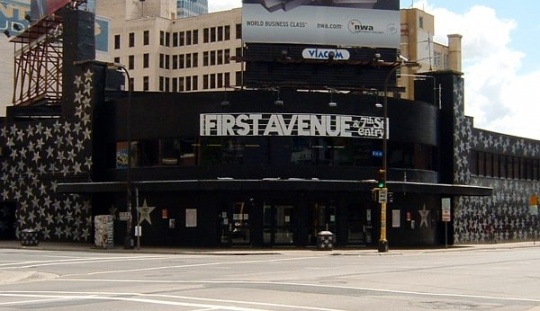
First Avenue
Articles
More Information
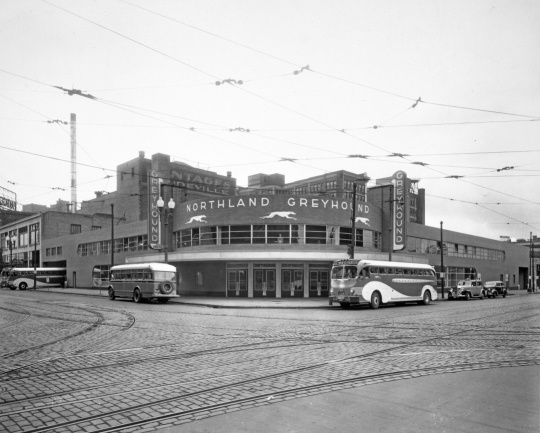
Greyhound Bus Depot
Holding Location
More Information
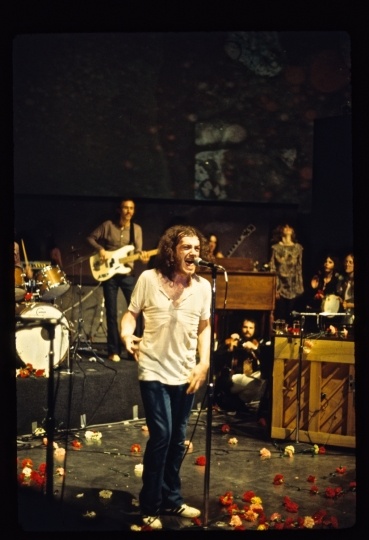
Joe Cocker performing at the Depot
All rights reserved
Articles
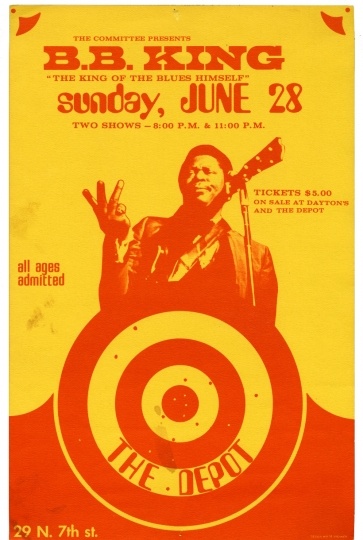
B. B. King concert poster
Holding Location
Articles
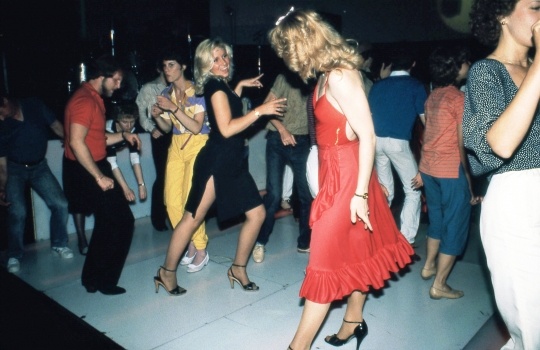
Disco dancers at Uncle Sam’s
All rights reserved
Articles

7th Street Entry handbill
Holding Location
Articles
More Information
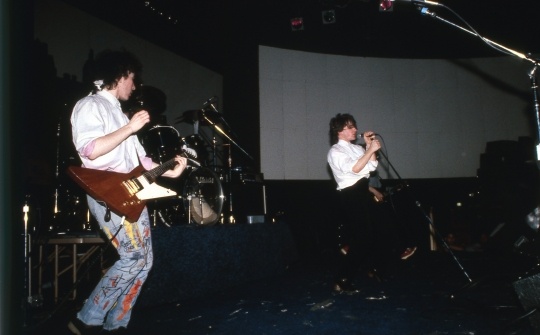
U2 performing at First Avenue
All rights reserved
Articles
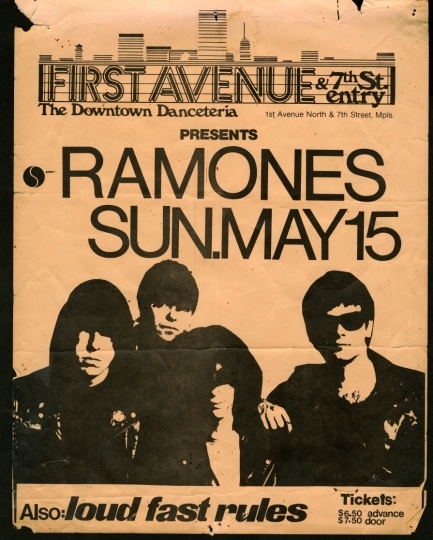
Handbill for Ramones concert at First Avenue
Holding Location
Articles
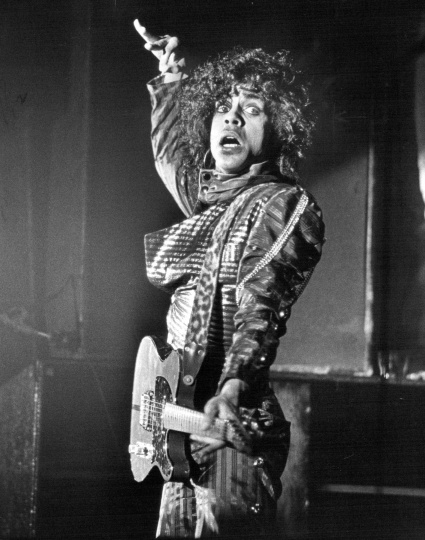
Prince performing at First Avenue in 1983
Prince performing at First Avenue. Photograph by David Brewster (Minneapolis Star Tribune), August 3, 1983.
All rights reserved
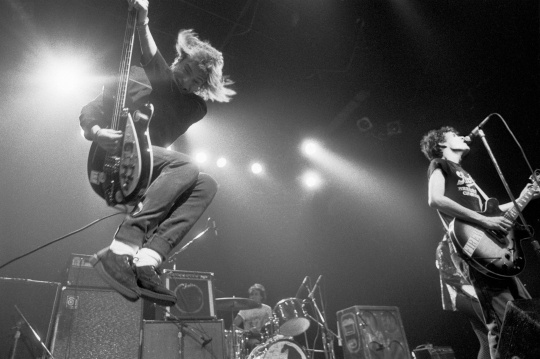
The Replacements at First Avenue
The Replacements at First Avenue in Minneapolis, 1984. Pictured are (left to right) Tommy Stinson, Chris Mars, and Paul Westerberg. From First Avenue: Minnesota’s Mainroom (Minnesota Historical Society Press, 2017), 119. Photograph by Daniel Corrigan; used with the permission of Daniel Corrigan.
All rights reserved
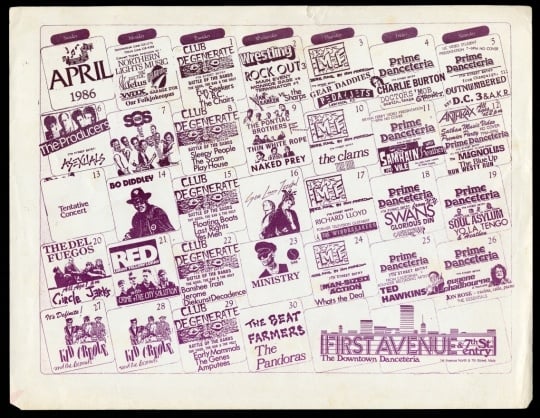
First Avenue calendar
Holding Location
Articles
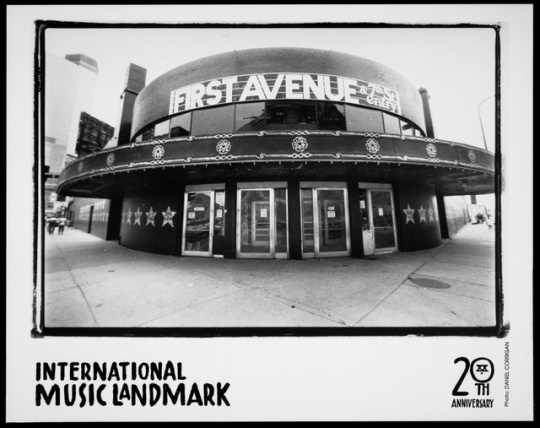
Entrance to First Avenue
All rights reserved
Holding Location
Articles
More Information

Babes in Toyland concert ticket
Holding Location
Articles
More Information
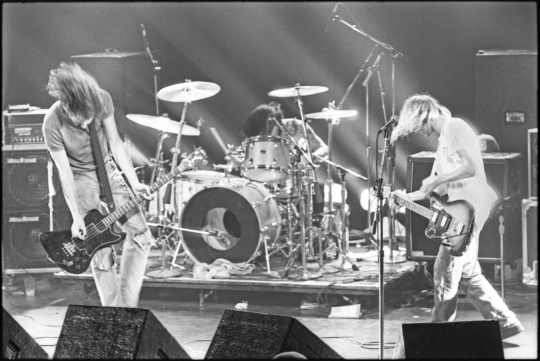
Nirvana performing at First Avenue
All rights reserved
Articles
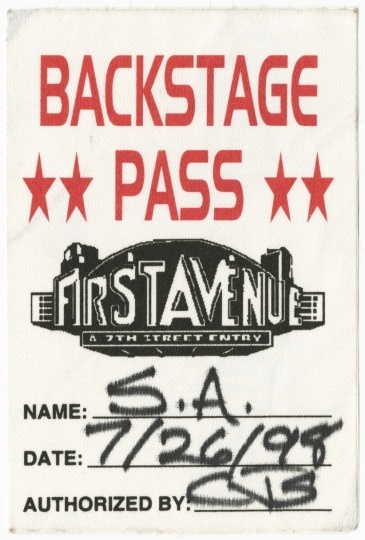
Soul Asylum backstage pass for concert at First Avenue
Holding Location
Articles
More Information
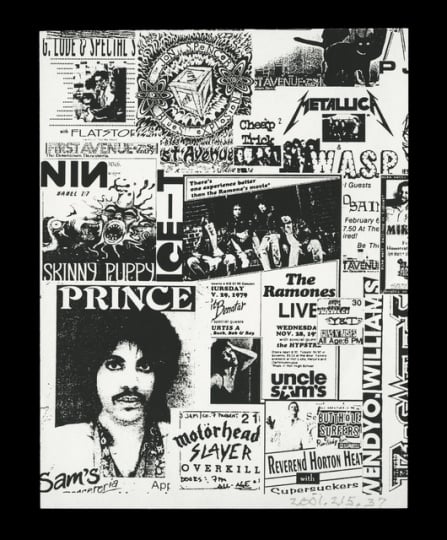
First Avenue thirtieth anniversary handbill
Holding Location
Articles
More Information
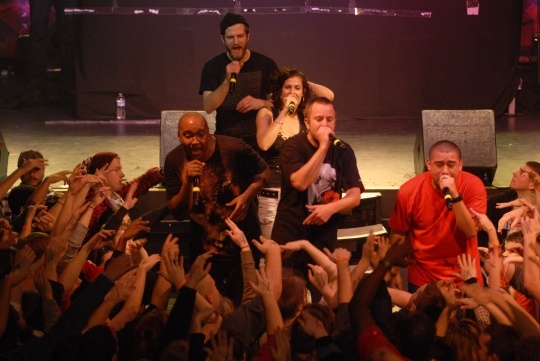
Doomtree performing at First Avenue
All rights reserved
Articles
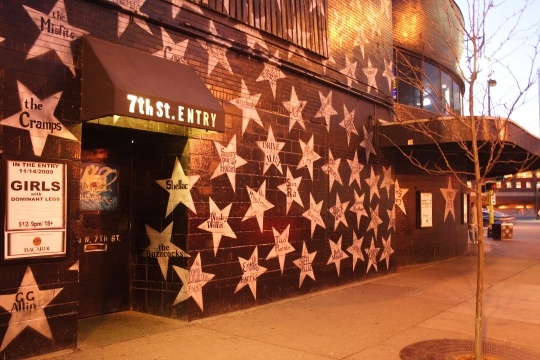
7th Street Entry
Public domain
Articles
More Information
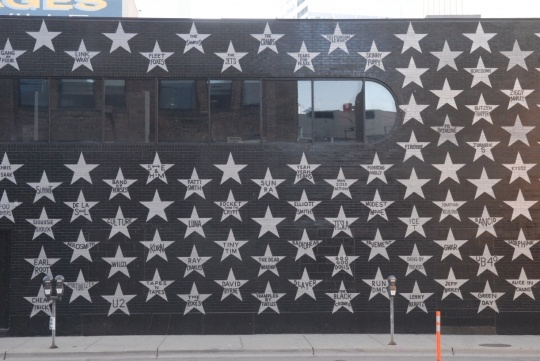
Stars on exterior wall of First Avenue
All rights reserved
Articles
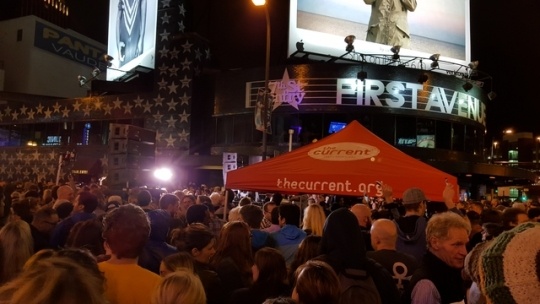
Dance party outside First Avenue after the death of Prince
Holding Location
Articles
More Information
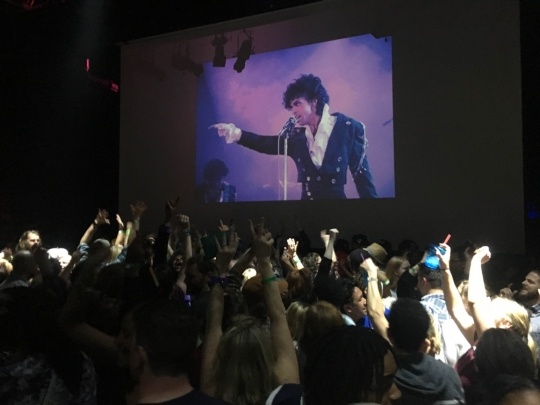
Dance party held as a memorial for Prince
Holding Location
Articles
More Information
Related Articles
Turning Point
Between November 26 and December 20, 1983, First Avenue closes to accommodate the filming of Prince’s Purple Rain. The success of the film (and the album of the same name) raises the club’s profile, making it internationally known and a tourist destination for aspiring musicians and music fans.
Chronology
February 26, 1937
April 3, 1970
June 12, 1971
July 1, 1972
March 21, 1980
November 28 and 29, 1979
January 28, 1980
March 9, 1981
December 31, 1981
August 3, 1983
July 1, 2000
November 2, 2004
November 16, 2004
2013
April 21, 2016
Bibliography
First Avenue. History.
http://first-avenue.com/history
Matos, Michaelangelo. “Everybody is a Star: How the Rock Club First Avenue Made Minneapolis the Center of Music in the `80s.” Pitchfork, March 14, 2016.
http://pitchfork.com/features/article/9832-everybody-is-a-star-how-the-rock-club-first-avenue-made-minneapolis-the-center-of-music-in-the-80s/
Noran, Rebecca. First Avenue & 7th Street Entry: Your Downtown Danceteria Since 1970. Minneapolis: First Avenue & 7th Street Entry, 2000.
Riemenschneider, Chris. First Avenue: Minnesota’s Mainroom. St. Paul: Minnesota Historical Society Press, 2017.
——— . “Prince and First Avenue: A History of the Club’s Ties to its Brightest Star.” Minneapolis Star Tribune, April 30, 2016.
http://www.startribune.com/prince-and-first-avenue-a-history-of-the-club-s-ties-to-its-brightest-star/377583391/#1
Swensson, Andrea. “Steve McClellan Talk about the Early Days of First Avenue and DEMO’s Bright New Future.” Local Current Blog, November 20, 2014.
http://blog.thecurrent.org/2014/11/steve-mcclellan-talks-about-the-early-days-of-first-avenue-and-demos-bright-new-future/
Related Resources
Primary
Band files and related records, 1977–2004
Manuscript Collection, Minnesota Historical Society, St. Paul
Description: The band files provide a chronological record of performances at First Avenue & 7th Street Entry during its first twenty-three years and offer a representative glimpse of the alternative and indie rock acts popular in the US during the period.
http://www2.mnhs.org/library/findaids/00233.xml
First Avenue Mpls: International Music Landmark; 20th Anniversary. [Minneapolis: First Avenue and 7th Street Entry, 1990].
Scholtes, Peter S. “First Avenue—The Legendary Bands. The Terrifying Toilets. An Oral History that Goes So Far Behind the Music It Will Leave You at a Gun Range Beneath the Stage.” City Pages, September 3, 2003.
Web
First Avenue.
http://first-avenue.com/






















